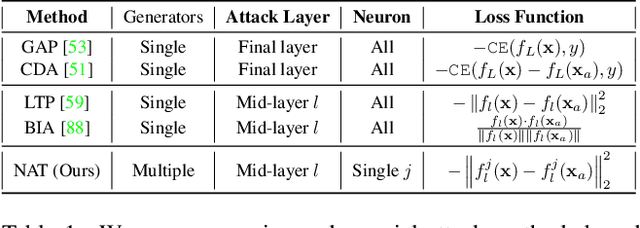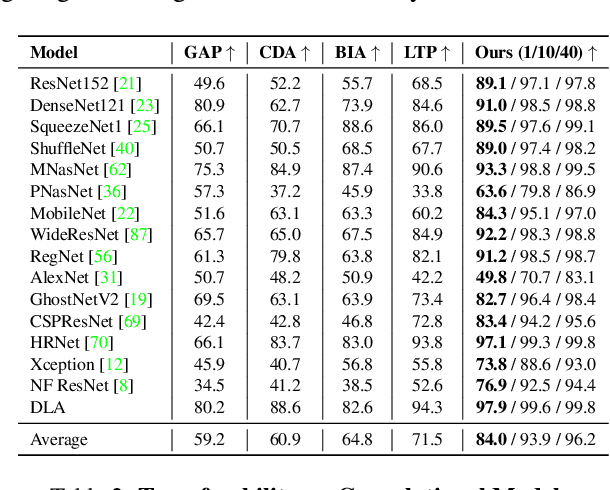Alexandre Alahi
EPFL
LayerSync: Self-aligning Intermediate Layers
Oct 14, 2025Abstract:We propose LayerSync, a domain-agnostic approach for improving the generation quality and the training efficiency of diffusion models. Prior studies have highlighted the connection between the quality of generation and the representations learned by diffusion models, showing that external guidance on model intermediate representations accelerates training. We reconceptualize this paradigm by regularizing diffusion models with their own intermediate representations. Building on the observation that representation quality varies across diffusion model layers, we show that the most semantically rich representations can act as an intrinsic guidance for weaker ones, reducing the need for external supervision. Our approach, LayerSync, is a self-sufficient, plug-and-play regularizer term with no overhead on diffusion model training and generalizes beyond the visual domain to other modalities. LayerSync requires no pretrained models nor additional data. We extensively evaluate the method on image generation and demonstrate its applicability to other domains such as audio, video, and motion generation. We show that it consistently improves the generation quality and the training efficiency. For example, we speed up the training of flow-based transformer by over 8.75x on ImageNet dataset and improved the generation quality by 23.6%. The code is available at https://github.com/vita-epfl/LayerSync.
RAP: 3D Rasterization Augmented End-to-End Planning
Oct 05, 2025Abstract:Imitation learning for end-to-end driving trains policies only on expert demonstrations. Once deployed in a closed loop, such policies lack recovery data: small mistakes cannot be corrected and quickly compound into failures. A promising direction is to generate alternative viewpoints and trajectories beyond the logged path. Prior work explores photorealistic digital twins via neural rendering or game engines, but these methods are prohibitively slow and costly, and thus mainly used for evaluation. In this work, we argue that photorealism is unnecessary for training end-to-end planners. What matters is semantic fidelity and scalability: driving depends on geometry and dynamics, not textures or lighting. Motivated by this, we propose 3D Rasterization, which replaces costly rendering with lightweight rasterization of annotated primitives, enabling augmentations such as counterfactual recovery maneuvers and cross-agent view synthesis. To transfer these synthetic views effectively to real-world deployment, we introduce a Raster-to-Real feature-space alignment that bridges the sim-to-real gap. Together, these components form Rasterization Augmented Planning (RAP), a scalable data augmentation pipeline for planning. RAP achieves state-of-the-art closed-loop robustness and long-tail generalization, ranking first on four major benchmarks: NAVSIM v1/v2, Waymo Open Dataset Vision-based E2E Driving, and Bench2Drive. Our results show that lightweight rasterization with feature alignment suffices to scale E2E training, offering a practical alternative to photorealistic rendering. Project page: https://alan-lanfeng.github.io/RAP/.
JointDiff: Bridging Continuous and Discrete in Multi-Agent Trajectory Generation
Sep 26, 2025Abstract:Generative models often treat continuous data and discrete events as separate processes, creating a gap in modeling complex systems where they interact synchronously. To bridge this gap, we introduce JointDiff, a novel diffusion framework designed to unify these two processes by simultaneously generating continuous spatio-temporal data and synchronous discrete events. We demonstrate its efficacy in the sports domain by simultaneously modeling multi-agent trajectories and key possession events. This joint modeling is validated with non-controllable generation and two novel controllable generation scenarios: weak-possessor-guidance, which offers flexible semantic control over game dynamics through a simple list of intended ball possessors, and text-guidance, which enables fine-grained, language-driven generation. To enable the conditioning with these guidance signals, we introduce CrossGuid, an effective conditioning operation for multi-agent domains. We also share a new unified sports benchmark enhanced with textual descriptions for soccer and football datasets. JointDiff achieves state-of-the-art performance, demonstrating that joint modeling is crucial for building realistic and controllable generative models for interactive systems.
SoccerNet 2025 Challenges Results
Aug 26, 2025Abstract:The SoccerNet 2025 Challenges mark the fifth annual edition of the SoccerNet open benchmarking effort, dedicated to advancing computer vision research in football video understanding. This year's challenges span four vision-based tasks: (1) Team Ball Action Spotting, focused on detecting ball-related actions in football broadcasts and assigning actions to teams; (2) Monocular Depth Estimation, targeting the recovery of scene geometry from single-camera broadcast clips through relative depth estimation for each pixel; (3) Multi-View Foul Recognition, requiring the analysis of multiple synchronized camera views to classify fouls and their severity; and (4) Game State Reconstruction, aimed at localizing and identifying all players from a broadcast video to reconstruct the game state on a 2D top-view of the field. Across all tasks, participants were provided with large-scale annotated datasets, unified evaluation protocols, and strong baselines as starting points. This report presents the results of each challenge, highlights the top-performing solutions, and provides insights into the progress made by the community. The SoccerNet Challenges continue to serve as a driving force for reproducible, open research at the intersection of computer vision, artificial intelligence, and sports. Detailed information about the tasks, challenges, and leaderboards can be found at https://www.soccer-net.org, with baselines and development kits available at https://github.com/SoccerNet.
NAT: Learning to Attack Neurons for Enhanced Adversarial Transferability
Aug 23, 2025



Abstract:The generation of transferable adversarial perturbations typically involves training a generator to maximize embedding separation between clean and adversarial images at a single mid-layer of a source model. In this work, we build on this approach and introduce Neuron Attack for Transferability (NAT), a method designed to target specific neuron within the embedding. Our approach is motivated by the observation that previous layer-level optimizations often disproportionately focus on a few neurons representing similar concepts, leaving other neurons within the attacked layer minimally affected. NAT shifts the focus from embedding-level separation to a more fundamental, neuron-specific approach. We find that targeting individual neurons effectively disrupts the core units of the neural network, providing a common basis for transferability across different models. Through extensive experiments on 41 diverse ImageNet models and 9 fine-grained models, NAT achieves fooling rates that surpass existing baselines by over 14\% in cross-model and 4\% in cross-domain settings. Furthermore, by leveraging the complementary attacking capabilities of the trained generators, we achieve impressive fooling rates within just 10 queries. Our code is available at: https://krishnakanthnakka.github.io/NAT/
OmniTraj: Pre-Training on Heterogeneous Data for Adaptive and Zero-Shot Human Trajectory Prediction
Jul 31, 2025Abstract:While large-scale pre-training has advanced human trajectory prediction, a critical challenge remains: zero-shot transfer to unseen dataset with varying temporal dynamics. State-of-the-art pre-trained models often require fine-tuning to adapt to new datasets with different frame rates or observation horizons, limiting their scalability and practical utility. In this work, we systematically investigate this limitation and propose a robust solution. We first demonstrate that existing data-aware discrete models struggle when transferred to new scenarios with shifted temporal setups. We then isolate the temporal generalization from dataset shift, revealing that a simple, explicit conditioning mechanism for temporal metadata is a highly effective solution. Based on this insight, we present OmniTraj, a Transformer-based model pre-trained on a large-scale, heterogeneous dataset. Our experiments show that explicitly conditioning on the frame rate enables OmniTraj to achieve state-of-the-art zero-shot transfer performance, reducing prediction error by over 70\% in challenging cross-setup scenarios. After fine-tuning, OmniTraj achieves state-of-the-art results on four datasets, including NBA, JTA, WorldPose, and ETH-UCY. The code is publicly available: https://github.com/vita-epfl/omnitraj
Social-Pose: Enhancing Trajectory Prediction with Human Body Pose
Jul 30, 2025Abstract:Accurate human trajectory prediction is one of the most crucial tasks for autonomous driving, ensuring its safety. Yet, existing models often fail to fully leverage the visual cues that humans subconsciously communicate when navigating the space. In this work, we study the benefits of predicting human trajectories using human body poses instead of solely their Cartesian space locations in time. We propose `Social-pose', an attention-based pose encoder that effectively captures the poses of all humans in a scene and their social relations. Our method can be integrated into various trajectory prediction architectures. We have conducted extensive experiments on state-of-the-art models (based on LSTM, GAN, MLP, and Transformer), and showed improvements over all of them on synthetic (Joint Track Auto) and real (Human3.6M, Pedestrians and Cyclists in Road Traffic, and JRDB) datasets. We also explored the advantages of using 2D versus 3D poses, as well as the effect of noisy poses and the application of our pose-based predictor in robot navigation scenarios.
From Generation to Generalization: Emergent Few-Shot Learning in Video Diffusion Models
Jun 08, 2025Abstract:Video Diffusion Models (VDMs) have emerged as powerful generative tools, capable of synthesizing high-quality spatiotemporal content. Yet, their potential goes far beyond mere video generation. We argue that the training dynamics of VDMs, driven by the need to model coherent sequences, naturally pushes them to internalize structured representations and an implicit understanding of the visual world. To probe the extent of this internal knowledge, we introduce a few-shot fine-tuning framework that repurposes VDMs for new tasks using only a handful of examples. Our method transforms each task into a visual transition, enabling the training of LoRA weights on short input-output sequences without altering the generative interface of a frozen VDM. Despite minimal supervision, the model exhibits strong generalization across diverse tasks, from low-level vision (for example, segmentation and pose estimation) to high-level reasoning (for example, on ARC-AGI). These results reframe VDMs as more than generative engines. They are adaptable visual learners with the potential to serve as the backbone for future foundation models in vision.
VoxDet: Rethinking 3D Semantic Occupancy Prediction as Dense Object Detection
Jun 05, 2025Abstract:3D semantic occupancy prediction aims to reconstruct the 3D geometry and semantics of the surrounding environment. With dense voxel labels, prior works typically formulate it as a dense segmentation task, independently classifying each voxel. However, this paradigm neglects critical instance-centric discriminability, leading to instance-level incompleteness and adjacent ambiguities. To address this, we highlight a free lunch of occupancy labels: the voxel-level class label implicitly provides insight at the instance level, which is overlooked by the community. Motivated by this observation, we first introduce a training-free Voxel-to-Instance (VoxNT) trick: a simple yet effective method that freely converts voxel-level class labels into instance-level offset labels. Building on this, we further propose VoxDet, an instance-centric framework that reformulates the voxel-level occupancy prediction as dense object detection by decoupling it into two sub-tasks: offset regression and semantic prediction. Specifically, based on the lifted 3D volume, VoxDet first uses (a) Spatially-decoupled Voxel Encoder to generate disentangled feature volumes for the two sub-tasks, which learn task-specific spatial deformation in the densely projected tri-perceptive space. Then, we deploy (b) Task-decoupled Dense Predictor to address this task via dense detection. Here, we first regress a 4D offset field to estimate distances (6 directions) between voxels and object borders in the voxel space. The regressed offsets are then used to guide the instance-level aggregation in the classification branch, achieving instance-aware prediction. Experiments show that VoxDet can be deployed on both camera and LiDAR input, jointly achieving state-of-the-art results on both benchmarks. VoxDet is not only highly efficient, but also achieves 63.0 IoU on the SemanticKITTI test set, ranking 1st on the online leaderboard.
X-GRM: Large Gaussian Reconstruction Model for Sparse-view X-rays to Computed Tomography
May 21, 2025Abstract:Computed Tomography serves as an indispensable tool in clinical workflows, providing non-invasive visualization of internal anatomical structures. Existing CT reconstruction works are limited to small-capacity model architecture, inflexible volume representation, and small-scale training data. In this paper, we present X-GRM (X-ray Gaussian Reconstruction Model), a large feedforward model for reconstructing 3D CT from sparse-view 2D X-ray projections. X-GRM employs a scalable transformer-based architecture to encode an arbitrary number of sparse X-ray inputs, where tokens from different views are integrated efficiently. Then, tokens are decoded into a new volume representation, named Voxel-based Gaussian Splatting (VoxGS), which enables efficient CT volume extraction and differentiable X-ray rendering. To support the training of X-GRM, we collect ReconX-15K, a large-scale CT reconstruction dataset containing around 15,000 CT/X-ray pairs across diverse organs, including the chest, abdomen, pelvis, and tooth etc. This combination of a high-capacity model, flexible volume representation, and large-scale training data empowers our model to produce high-quality reconstructions from various testing inputs, including in-domain and out-domain X-ray projections. Project Page: https://github.com/CUHK-AIM-Group/X-GRM.
 Add to Chrome
Add to Chrome Add to Firefox
Add to Firefox Add to Edge
Add to Edge